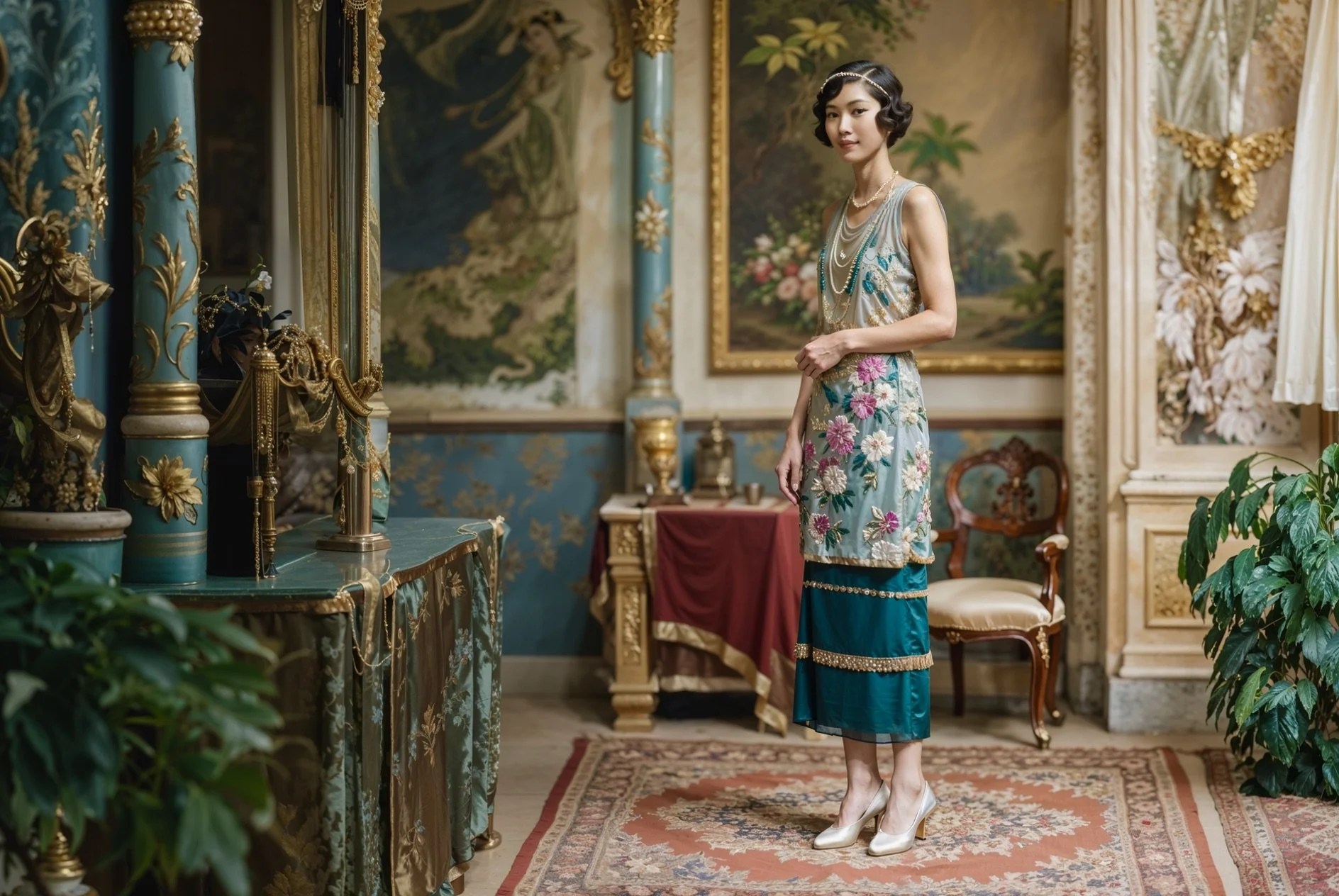แฟชั่นสตรีไทยสมัยปลายรัชกาลที่ ๖: จุดเปลี่ยนผ่านจากความงามแบบเอ็ดเวิร์ดเดียนสู่ความทันสมัยแบบอาร์ตเดโค
แฟชั่นสตรีไทยสมัยปลายรัชกาลที่ ๖: จุดเปลี่ยนผ่านจากความงามแบบเอ็ดเวิร์ดเดียนสู่ความทันสมัยแบบอาร์ตเดโค (ราว ค.ศ. 1920 ในปลายรัชกาลที่ 6)
ในช่วงปลายรัชกาลพระบาทสมเด็จพระมงกุฎเกล้าเจ้าอยู่หัว (รัชกาลที่ 6 ครองราชย์ พ.ศ. 2453–2468) ประเทศสยามกำลังอยู่ในช่วงเปลี่ยนผ่านทางวัฒนธรรม ขณะเดียวกันกระแสแฟชั่นตะวันตกก็เข้าสู่ยุคใหม่อย่างรวดเร็ว หลังสงครามโลกครั้งที่ 1 สตรีในสังคมชั้นสูงของไทยเริ่มแต่งกายผสมผสานกลิ่นอายของแฟชั่นปลายยุคเอ็ดเวิร์ด (Edwardian) กับกระแสความทันสมัยของยุคอาร์ตเดโค (Art Deco) ในยุคทศวรรษ 1920 ได้อย่างมีเอกลักษณ์ โดยเฉพาะการสวมเสื้อผ้าท่อนบนที่มีขายเสื้อยาวกับกระโปรงยาวทรงกระบอกแบบไทย ที่สะท้อนรูปทรงเสื้อผ้าตะวันตกแบบใหม่โดยไม่ทิ้งความงามแบบไทยดั้งเดิม
จากความงามแบบเอ็ดเวิร์ดเดียนสู่เสรีภาพในยุคแจ๊ส
แฟชั่นปลายยุคเอ็ดเวิร์ดเดียน (ราว พ.ศ. 2453–2457) มีลักษณะเด่นที่เน้นความสง่างาม อ่อนช้อย ด้วยเสื้อผ้าทรงเข้ารูป กระโปรงบานยาว และการประดับลูกไม้ ปักเลื่อม หรือเย็บดอกไม้ผ้าอย่างประณีต ส่วนเส้นผมจะไว้ยาว ม้วนเป็นทรงพองคล้าย ‘Gibson Girl’ ที่แสดงออกถึงอุดมคติของหญิงงามยุคนั้น
แต่ในช่วงทศวรรษ 1920 หลังสงครามโลกครั้งที่ 1 สตรีตะวันตกเริ่มปฏิวัติตนเองด้วยแฟชั่นแบบ “แฟลปเปอร์” ที่เน้นความทะมัดทะแมง กระฉับกระเฉง กระโปรงสั้นขึ้น เอวต่ำลง เสื้อตัวหลวม และทรงผมสั้นดัดเป็นลอน เรียกว่า finger wave เสริมด้วยเครื่องประดับอย่างผ้าคาดศีรษะ (bandeau), สร้อยไข่มุกยาว, ถุงมือขาว และหมวกปีกกว้างหรือหมวกโคลช (cloche hat) ซึ่งเป็นสัญลักษณ์ของความเปลี่ยนแปลงทางสังคมและบทบาทของสตรีสมัยใหม่
การตีความแบบไทย: งามอย่างสมัยใหม่ไม่ละทิ้งรากเหง้า
สิ่งที่น่าสนใจในแฟชั่นสตรีไทยยุคนี้ คือการ ดัดแปลงรูปทรงแฟชั่นตะวันตกให้เข้ากับความงามและกิริยาแบบไทย แทนที่จะสวมเดรสสั้นแบบตะวันตก สตรีไทยในชั้นสูงมักสวมกระโปรงยาวทรงกระบอก หรือผ้าซิ่น ร่วมกับเสื้อตัวหลวมที่ยาวคลุมสะโพก และมีการเย็บปักอย่างประณีต เลียนแบบโครงสร้างของชุดแฟลปเปอร์แต่ยังคงความสุภาพอ่อนหวานแบบไทย
องค์ประกอบสำคัญของแฟชั่นไทยในยุค 1920
เสื้อยาวกับกระโปรงทรงกระบอก – เสื้อตัวบนเป็นผ้าโปร่งหรือลูกไม้เย็บติดเลื่อม มีชายเสื้อคลุมสะโพกหรือทิ้งชายระบาย เพื่อให้เกิดแนวเอวต่ำแบบตะวันตก ขณะที่กระโปรงทรงกระบอกยาวกลางหน้าแข้งทำหน้าที่แทนกระโปรงสั้นแบบ flapper ได้อย่างเหมาะสมในบริบทไทย
ผ้าปักและการตกแต่ง – ใช้ผ้าโปร่ง ผ้าชีฟอง และผ้าไหมปักเลื่อม ลวดลายดอกไม้ หรือแพตเทิร์นเรขาคณิตแบบ Art Deco เสริมให้ชุดดูหรูหราแต่ยังโปร่งสบายเหมาะกับอากาศร้อน
เครื่องประดับ – หมวกฟางปีกกว้างติดดอกไม้ประดับ และผ้าคาดศีรษะประดับไข่มุกหรือเลื่อม ได้รับความนิยมในหมู่สาวสมัยใหม่ ถุงมือขาวและถุงน่องสีขาวก็ถูกนำมาใช้ในโอกาสพิเศษหรือการถ่ายภาพพอร์เทรต
ทรงผม – จากผมยาวในสมัยเอ็ดเวิร์ดเริ่มเปลี่ยนเป็นทรงสั้นระดับติ่งหู หรือสั้นแค่ต้นคอ และนิยมดัดลอนเป็น finger wave เพื่อให้ได้รูปลักษณ์สาว flapper ที่ทะมัดทะแมงและทันสมัย
รองเท้า – รองเท้าส้นสูงทรงเรียวทำจากผ้าไหมหรือหนังสีอ่อน ตกแต่งด้วยดอกไม้หรือโบว์เล็ก ๆ เข้าชุดกับเสื้อผ้าและถุงน่องสีขาว
บริบททางวัฒนธรรมและภาพลักษณ์ร่วมสมัย
ยุคนี้คือช่วงเวลาของการตื่นตัวทางสังคม การศึกษา และความคิดแบบประชาธิปไตยสมัยใหม่ในราชสำนักสยาม สตรีชั้นสูงปรากฏกายในภาพถ่ายแบบสตูดิโอด้วยเครื่องแต่งกายที่แสดงออกถึงการผสมผสานระหว่างความเป็นไทยและตะวันตกได้อย่างลงตัว ทั้งงดงาม สง่างาม และแฝงความมั่นใจในบทบาทใหม่
แฟชั่นจึงไม่ใช่แค่เสื้อผ้า แต่คือการ สื่อสารอัตลักษณ์ของหญิงไทยในยุคแห่งการเปลี่ยนผ่าน — ระหว่างโลกเก่าและโลกใหม่ — ที่งามทั้งในความเรียบง่ายและในความกล้าเผชิญโลกภายนอกอย่างสง่างามและมั่นใจ
Between Eras and Empires: Thai Women’s Fashion at the Crossroads of Edwardian Grace and Flapper Modernity (c.1920s, Late Rama VI)
During the late reign of King Vajiravudh (Rama VI, r. 1910–1925), Thailand—then Siam—was undergoing a profound cultural transformation. As the world emerged from the shadows of the First World War, Western fashion surged forward with radical change. In this era, Thai upper-class women's fashion reflected a unique blend of late Edwardian sophistication and the bold energy of the Roaring Twenties. Nowhere is this fusion more beautifully illustrated than in the adoption of the long tubular skirt and draped chiffon blouses, styled to mirror the flapper silhouette while retaining traditional Thai modesty and grace.
From Edwardian Elegance to the Jazz Age
Late Edwardian fashion (circa 1910–1919), particularly during the years leading up to World War I, was defined by high waistlines, S-bend corsets, and flowing skirts with intricate embroidery. Fabrics such as silk and lace were popular, often layered and detailed with floral appliqués. Hairstyles remained long, often styled in pompadours or Gibson Girl waves.
In contrast, the flapper look of the 1920s introduced a new silhouette altogether: low-waisted dresses, looser cuts, and shorter hemlines. It was a rebellion against corsetry and constraint. The signature elements included sheer fabrics, art deco embellishments, sleeveless designs, and a boxy, youthful silhouette. Hair was cropped into bobs and finger waves, hats became cloche-shaped or wide-brimmed, and accessories like bandeaux, long pearl necklaces, and white glovescompleted the look.
A Thai Interpretation: Fashion at the Threshold of Change
What makes early 1920s Thai fashion remarkable is how it translated Western silhouettes into the context of Thai cultural aesthetics. Instead of adopting the short flapper dress directly, Thai women embraced elongated sarong-style skirts—straight and tubular in form—that allowed them to reflect the long, lean lines of Western evening dresses while preserving modesty.
These skirts were paired with draped chiffon or silk blouses, often ornately beaded, echoing the lavish embellishments of flapper attire. Sleeves remained short or sheer, a nod to the new Western preference for bare arms, while the waistline dropped to the hips, mimicking the flapper dress construction. The result was a look that felt entirely modern while rooted in Siamese sensibility.
Key Elements in Thai 1920s Fashion
Long Blouse and Skirt Ensemble: Mimicked the one-piece flapper dress but separated into blouse and skirt, often coordinated in tone or richly contrasted in jewel tones—orchid purples, golds, midnight blues, and soft creams.
Embellishment and Fabric: Embroidery, sequins, and floral appliqués were used liberally. Chiffon, satin, and organza gave a delicate, ethereal quality to these outfits—light enough for tropical climates, yet glamorous in European style.
Accessories: Thai ladies began adopting wide-brimmed straw hats with floral trims for outdoor appearances, alongside bandeau-style headbands and pearl strands. White gloves and white stockings became staples for formal portraiture and ceremonial wear, reinforcing Western propriety.
Hairstyles: The transformation from Edwardian volume to 1920s neatness was evident in the adoption of the finger wave and bobbed cuts, with hair carefully sculpted to frame the face—an elegant adaptation to the flapper’s rebellious crop.
Shoes: Heeled satin pumps with almond toes, often decorated with floral or bow accents, replaced traditional footwear. Stockings were worn, even in tropical heat, signalling adherence to Western dress etiquette.
Cultural Context and Visual Legacy
This was a time of "prachathipatai samai mai" (new era constitutional thinking) and increased exposure to Western norms. The women portrayed in studio portraits from this period exude both the confidence of modernity and the poise of courtly training. They embody the cultural dialogue between East and West, old and new, tradition and modernity.
Fashion, in this sense, became more than clothing—it was a soft expression of a kingdom finding its place in the modern world. As Thailand stepped into the modern era, women’s clothing evolved to reflect a hybrid identity: cosmopolitan yet rooted, fashionable yet culturally distinct.
#aifashionlab #AI #aiartist #aiart #aifashion #aifashiondesign #aifashionstyling #aifashiondesigner #fashion #fashionhistory #historyoffashion #fashionstyling #fashionphotography #digitalfashion #digitalfashiondesign #digitalcostumedesign #digitaldesign #digitalaiart #ThaiFashionHistory #ThaiFashionAI #flux #fluxlora #fluxkontext
















































































